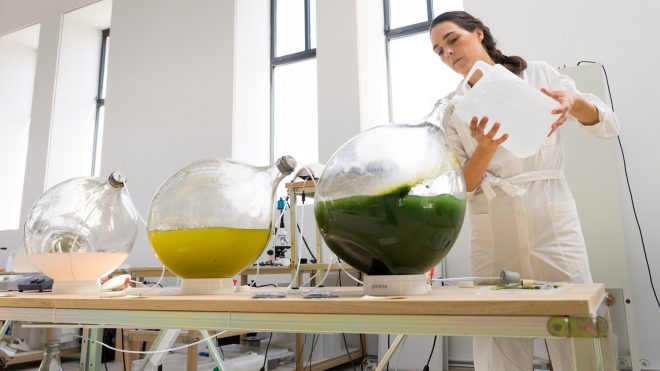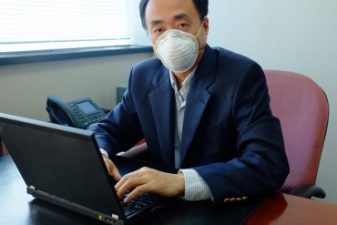
The gold dust bought at Walmart may make your graduation photo pretty. But one blow and it’s forever cycling as microplastics that will get into our lungs.
I wonder all the time about Covid 19. Why now? Why aren’t we stopping it? How did it get to invade us in such a quiet way, with such a profound impact on our lives? Most of us didn’t get the message with the planet heating up. Global warming was one message for the way humanity is scaling its growth on a planet that once seemed so giant, which now seems very small. But most of us didn’t listen. Covid-19 is now personal and it’s an important messenger when we link pollution exposure to lung health.
A new study by researchers from Utah State University show that microplastics, the tiny bits of plastic that pervade our oceans and now the stomachs and bodies of marine life, and ultimately us –– has found a new route into our body: through the air we breath. And it’s everywhere.
A recent study that looked at dust at 11 American locations from the Joshua Tree National Park in California to the Wind River Range in Wyoming found that up to 6% of all the dust collected at those locations were made up from microplastics. That’s scary since outdoor pollution causes about 7 million premature deaths a year in the world, and is associated with pulmonary disease.
Could it be that microplastics in our lungs just makes it easier for Covid-19 to take over?
According to Janice Brahney, an assistant professor at Utah State, microplastics may be more toxic than other industrial pollution and dust. The fact is that we just don’t know. “That we can breath in microplastics has been known for decades,” she says in an opinion article in the NY Times, “we just haven’t fully appreciated the scale of the problem.”
Microplastics come from the cheap synthetic clothing we buy at H&M (they tried being sustainable once) and Forever 21. They come from the cheap plastic toys and floating unicorns you buy for the kids at the lake. They come from plastic bags and packaging that your baby cucumbers come in at the supermarket. They may be banned in cosmetics, but they come from car tires, Dollar Store toys, and basically most of the non-organic trash you throw away every single day.
Bioplastics made from organic material
Of course we need sustainable alternatives, like advancing technologies that use non-plastic solutions. Like algae-based plastics, or plastics made from potato starch, or cocoa bean shells made by the Dutch duo designers Eric Klarenbeek and Maartje Dros. Leave it to the Dutch to be dreamers. They know how to plug away at practical solutions when facing adversity. Growing up in a Dutch household I was often told the story of our strength is as small as your thumb. You don’t need to be a giant to think about sticking your thumb into a hole to plug a leaking dyke.

Other organic options include corn starch, straw, woodchips, sawdust, and recycled food waste. While cities around the world rush to ban plastics, very little happens after the feel good statement. It’s impossible to enforce plastic bans in cities where shops do what they want and then as an alternative sell the much more polluting and ugly plastic reusable bag that don’t stand the test of time and which just build up in your basement until you throw them out. Get some canvas options that look good and you will use less plastic.
So much of the plastic we use needs to go away and that starts with ending our addiction to takeaway and bottled soda, plastic bags for everything and packaging everywhere including on the fruits and veggies we eat.

LEGO, anyone over in HQ listening? Can’t you make one of the world’s favorite toys in a more sustainable way?
Those weird people that challenge themselves to be “carbonauts” or take low-carbon and zero-plastic waste challenges are running a waste-free marathon for themselves. They are doing it for us to show it can be done.
Bioplastic producers include
- 3fD
- BASF
- BioApply Polymers
- Braskem
- Biofase
- BioSphere Plastic
- Cardia Bioplastics
- Purac
8 tips for cutting down on microplastics:
- Avoid shampoos and creams that have pearly textures. And polymer beads. The “pearls” are microplastics. The beads unless certified otherwise are likely plastic. Buy body care products at a health food store that hires knowledgable people. The mom and pop shops are usually the best.
- Bring your own bottle and cool coffee cup. Find them in ceramics, with a silicon lid
- Buy cotton, better organic, and avoid synthetic throw-away clothing
- Buy second hand clothing at vintage and thrift shops
- Say no to plastic bags at checkout, and say yes only to cool canvas bags or backpacks –– easier to carry by bike or electric moped
- Give up synthetic gum, buy the real stuff instead at natural food stores
- Buy tea bags made with cotton, or just buy tea leaves (better, fresher)
- Say no to straws, glitter, Dollar Store plastic novelty items, cling wrap



